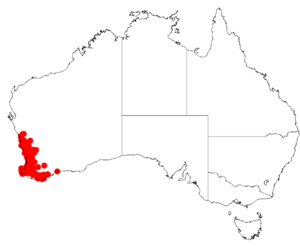Viscid hand-flower facts for kids
Quick facts for kids Viscid hand-flower |
|
|---|---|
 |
|
| Scientific classification | |
| Genus: |
Scaevola (plant)
|
| Species: |
glandulifera
|
 |
|
| Occurrence data from Australasian Virtual Herbarium | |
| Synonyms | |
|
Lobelia glandulifera Kuntze |
|
Meet the viscid hand-flower, also known as Scaevola glandulifera. This special shrub is part of the Goodeniaceae plant family. You can only find it growing naturally in Western Australia.
Contents
What Does It Look Like?
Scaevola glandulifera is a shrub that stands upright. It can grow up to 50 centimeters (about 20 inches) tall. Its stems are smooth and do not have any ridges.
Leaves and Flowers
The leaves of this plant do not have stalks. They attach directly to the stem. Some leaves have smooth edges, while others have small teeth. Each leaf blade can be between 2 to 9 centimeters long and 1 to 10 millimeters wide.
The flowers grow in clusters at the very end of the stems. These flower clusters are called spikes. Each flower's petals, known as the corolla, are 10 to 30 millimeters long. They have short, sticky hairs on the outside. Sometimes, you might see longer, stiff, yellow hairs too.
Inside the flower, it looks like it has a beard! The flowers are a beautiful deep blue-purple color. The part of the flower that holds the seeds, called the ovary, has two sections. There is a small cup that holds the style, which is about 1.5 to 3 millimeters wide. This cup is hairy both inside and out.
Fruit
After the flowers, the plant produces small fruits. These fruits are shaped like an upside-down egg. They can grow up to 4 millimeters long. Some fruits have a hairy surface, and some do not.
When Does It Flower?
You can see the viscid hand-flower blooming from August to December. Sometimes, it even flowers into January.
Where Does It Grow?
In Western Australia, Scaevola glandulifera grows in several different areas. These areas are part of the IBRA bioregions. You can find it in places like the Geraldton Sandplains, Swan Coastal Plain, Avon Wheatbelt, Jarrah Forest, Warren, and Esperance Plains. It also grows in the South West Botanical Province.
Naming and History
The scientific name Scaevola glandulifera was first given to this plant in 1839. It was described by a scientist named Augustin Pyramus de Candolle. He wrote about it in a book called Prodromus Systematis Naturalis Regni Vegetabilis.
What Do the Names Mean?
The first part of the name, Scaevola, comes from Latin. It means "left-handed." This name refers to an ancient Roman hero named Gaius Mucius Scaevola. He was famous for being left-handed. The flowers of this plant are said to look a bit like a hand.
The second part of the name, glandulifera, also comes from Latin. "Glandula" means "gland," and "ferre" means "to carry" or "to bear." So, glandulifera means "gland-bearing." This refers to the sticky, gland-like hairs found on the plant.

